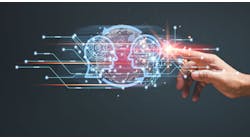It’s 2019, and the Industrial Internet of Things (IIoT) is still here. Those naysayers, convinced it’s just a fad or some marketing gimmick, seem almost confused by its perseverance. The truth is it’s gone from concept to reality before our eyes. As it continues to define itself, one thing is certain: the digital twin will be a part of that definition.
“The concept of the digital twin is not new,” explained Todd Snide, group senior expert at Schneider Electric, who presented the paper he co-wrote with Merrill Harriman at the ODVA 2018 Industry Conference in Stone Mountain, Georgia. “Industrial automation agents have been around a long time. The digital twin takes this concept to the next level.”
There are many definitions of the digital twin. “It’s a digital or cyber representation that’s attached to a physical device,” explained Snide. “This isn’t ‘happy engineering’—engineering for engineering’s sake. The digital twin is an exact operational duplicate of the device, upon the discretion of the user. Configuration can be done off-line or on-line through the twin. The digital twin could only exist off-line as an independent element for simulation and verification.”
The digital twin knows more about the device than the device knows about itself, said Snide. “Critical information about the device, such as bill of materials, material composition or damaging conditions, can be linked or contained in the twin,” he explained. “And the digital twin can be available, even when the device is not. The twin will be the main entry point for communicating with the device. There is no need to develop new configuration standards.”
Digital twins also must be able to talk with other digital twins. “Inside an automation system, the digital twin is the primary resource for interaction,” explained Snide. “The system must operate, even if the twin is off-line and not available. The system must be robust enough to operate without the twin. The location of the digital twin can be anywhere it is practical to be placed. It can in on-prem or in an external cloud.”
In a system where there are hundreds or thousands of devices and twins, manual configuration isn’t practical. There must be a means for mass on-line configuration of the digital twins.
“We know there will be changes to CIP needed to support digital twins,” admitted Snide. “Redundant owner for I/O will be important for using multiple twins for the same asset.”
ODVA’s development of xDS, replacing the electronic data sheet (EDS), will assist and complement digital twin development. Since xDS has access to a large portion of the information and documentation for the physical device it’s attached to, its use should be proportional. Most of the configuration data for the digital twin will be in the xDS file, which can be updated without updating the physical device. The xDS file is conformance-tested and certified, ensuring the digital twin remains current within the automation system.
The digital twin brings greater operational efficiency, more profitable operation, new services, simplification of commissioning and simulation as a service to automation systems, explained Snide.
Commissioning as a service is an iterative precommissioning service based around the control function, in which you choose the assets and see how they fit before committing. Reconfigurable manufacturing means significant changes to the process can be tested with known impact and known execution.
“Digital twins bring the fun back to automation systems by tying in to the millennials’ attraction to digital,” offered Snide. “Digital twins are the future. They’re coming. hey’re going to happen. Digital twins will positively affect the customer’s bottom line, and all digital twins must work together. Therefore we must find some standardization. We’re all in this together.”





